Sculpting the Future in Ossining
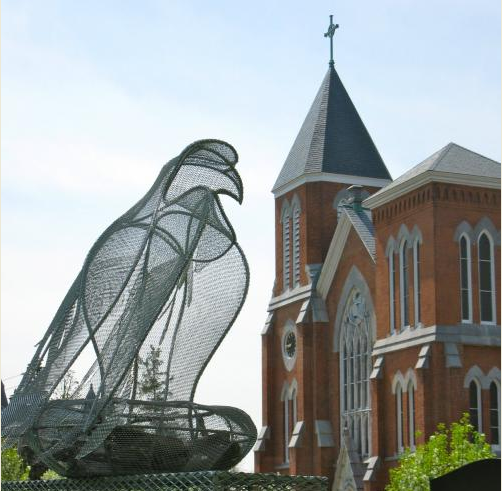
My guest blogger this week is Jonah Jeng, our talented Communications intern who also happens to be a terrific writer with a knack for analyzing art. He just finished his freshman year at the University of Rochester, where he’s double majoring in brain & cognitive science and film & media studies. I gave Jonah an assignment to head up to Ossining, to check out the Village’s bicentennial outdoor sculpture exhibit. He wrote the following article – that really gives a feel for both the art and the Village’s personality – and I chipped in by taking photos of the sculptures. Enjoy!
Top photo: “Crossroads Aerie” by Sarah Haviland
***
To celebrate its bicentennial, the Village of Ossining has erected a large-scale 25-piece outdoor sculpture exhibit that will be on display through October 26. It’s quite the sight. The exhibit winds its way through yards, sidewalks, and plazas, interspersed among the town’s historic buildings and along the banks of the waterfront. Next to the Trinity Episcopal, a blue circle incandesces from the thousands of light-reflecting sequins embedded in its surface. Stained glass windows line the walls of the Ossining Train Station overpass, while a mélange of abstracted car parts looms on the lawn of the Washington School. The selection is that diverse, ranging from traditional methods to exuberant pop art, woodwork to steel forgery. Installed in just two days, the entire exhibit is a feat of near-monumental proportions, the combined effort of careful planning and passionate artistic vision.
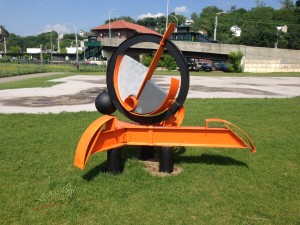
“Inter-Sections” by Jerome Harris Parmet
It’s true the sculptures could have been presented in one centralized location. It would have made viewing them more convenient, and the environment created by having so much art in one place would certainly have been aesthetically nourishing. But by being distributed all over Ossining, the exhibit makes a statement. It presents the town as interconnected; a place where creativity and inspiration can arise from any corner or street, where art is absorbed so completely that it runs through the body of Ossining like lifeblood. Moreover, because the sculptures are so widely dispersed, a tour would require walking through the heart of Ossining, taking in the personality of the town along with the exhibit itself. Really, the town’s architecture and social atmosphere are as much on display as the sculptures, which serve only to enrich Ossining’s preexisting character.
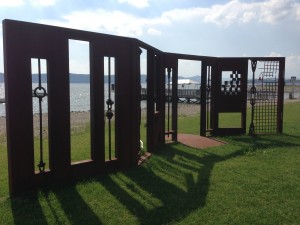
“Homenaje a Carlos Zook” by Peter Barrett
As for the actual sculptures themselves, they seem to embody ideas older than the town itself, using them to characterize Ossining’s vibrant history. “Honoring the past” is the first part of the exhibit’s motto, and appropriately, the sculptures pay their respects to life, love, and movement, things we associate with humanity at its most dynamic. “Dancing Milkweed” curves and bends atop a pedestal, as if a ballerina’s trajectory had been traced over with an impasto brush and then frozen in time. “Embrace” speaks for itself, and it is one of the exhibit’s largest sculptures, an outstanding symbol of warmth and acceptance. Nature and religion, seen by many as the sources of life, enter the picture as well with works like “Stamen,” “Cedar Cluster” and “Heritage Two,” an emblematic tree of nails outside the First Baptist Church.
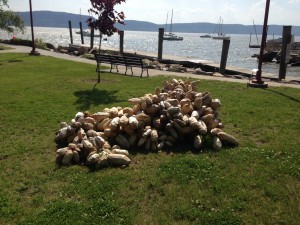
“Cedar Cluster” by Matthew Weber
But those same sculptures could also be seen as “embracing the future,” the second part of the exhibit’s motto and Ossining’s promise to uphold the humanistic beauty it had witnessed and fostered over the past two centuries. Art, by nature of being present-tense, sits at the junction between past and future and is therefore the perfect way to both celebrate the town’s historic vitality and cite that same vitality as the invigorating reason why Ossining should and can continue pressing onward through the coming years. In a way, the exhibit functions as a village-wide pep rally. It unifies the town and equips it with a spirit hungry for the future. It’s saying, to borrow the title of one of the featured sculptures, “Let’s Roll.”
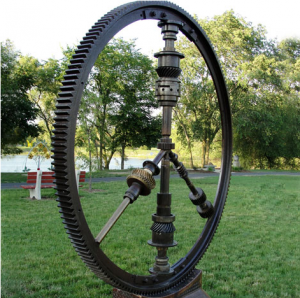
“Let’s Roll” by
James Havens
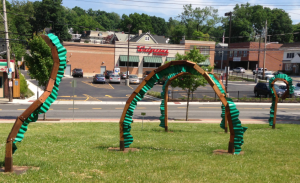
“In a Sea of Grass” by Elizabeth Barksdale
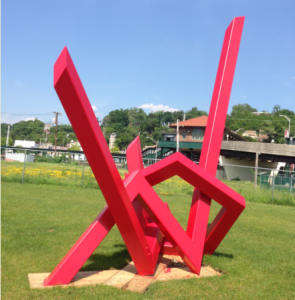
“Untitled” by Eric Stein
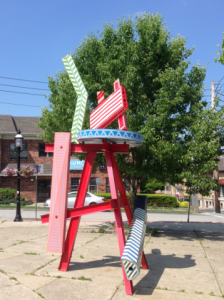
“Lord Mr. Ford, Look What You Have Done” by Matt Harding
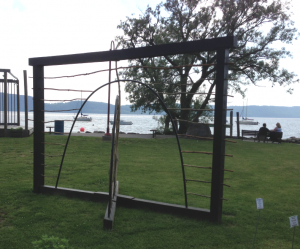
“Double Arch” by Gary Orlinsky


Connect with Janet